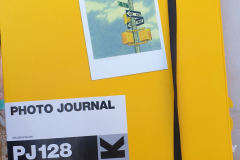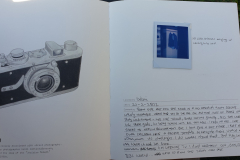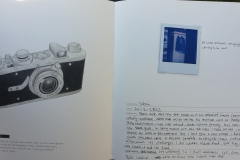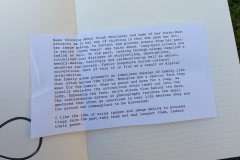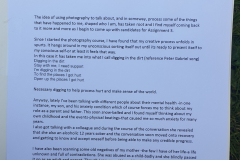Assignment 3 Self Portraiture Write Up
Drawing upon the examples in Part Three and your own research, you can approach your self-portraits however you see fit. You may choose to explore your identity or masquerade as someone else, or use empty locations or objects to speak of your experiences. However you choose to approach it, use yourself –directly or indirectly – as subject matter.
Keep a diary for a set period of time (at least two weeks). Each day write two or three pages about yourself – what you’ve been doing/thinking. This can be as specific or poetic as you wish. You may wish to pick a theme for the duration. This is an open brief designed to give you freedom to create something personal which suits you best. Use the artists you’ve looked at in Part Three or your own research for inspiration. Select the most interesting parts of the diary (which could also be the most banal or mundane) and interpret them into a photographic project. A good way to approach selection could be to ask a friend / fellow student / stranger to read it and send back a highlighted version. You could then base your project on those parts. This would take the pressure off
you to find a ‘good story’.
You may choose to select a few days or phrases that spark an idea for you, or you may wish to exaggerate how you were feeling one day into a parody of yourself or the circumstance. You may wish to create a ‘document’ of that time in a re-creation of events – or direct a model to act out some of the content of the diary, making your own ‘film-stills’.
You could present your chosen diary entries as a visual diary or use it as a springboard for further exploration. You may choose to insert the pictures like snapshots into your diary and hand it all in together. You don’t have to restrict yourself to the diary itself; you may decide to use it to take you into new territory.
Send your finished piece to your tutor by the method agreed together with an introduction of around 300 words briefly setting out your rationale and how you approached this project. You should also send to your tutor the relevant
pages of your learning log or blog url.
Introduction
At the start of this assignment-keeping a diary- I struggled to find any rhythm. I’ve never been a diary person although I do keep a small notebook to write down ideas for photos or projects or just even observations. But I persevered and eventually shrugged off any self-conscious feelings I had about writing and sharing my thoughts. To be honest, I wrote when the mood took me and sometimes it flowed, other times it was just a few lines.
As entries began to take shape, I realised I was unearthing a theme – childhood events and their lasting effects. By the end of roughly 14 entries, I had an idea for a series of images based on self-absented portraiture.
The diary is not something I would continue as I find my small notebook works just as well. It comes with me everywhere and helps me record ideas, inspirations and observations in a more authentic manner-less performative than diary writing.
Research & Approach
Having read and done the exercises for the three portraiture modes described in the course material-autobiographical, masquerades and self-absented, I was inspired by elements from each approach, the following artists, and other sources that highlight photographers who use their mental health experiences as source material for their work, including:
Elina Brotherus
Elina Brotherus’s series ‘Anonciation’ explores her coming to terms with failed IVF treatments, as she explains ‘My way of discussing the matter is to give out the pictures, not to give an interview. I’m not sure if I will be able to actually speak about this. I’m still too sad.’
This quote more than any other resonated with me and prompted me to explore the key theme in the series-child abuse. These days this is not an uncommon theme and is discussed more openly than say twenty years ago, but its long-term damage is often overlooked.
Trish Morrissey
In her series ‘Seven Years’ Morrissey explores the family album as a concept, its rituals-story telling of events- and how it’s being replaced by digital photos and fast becoming a historical artefact. Morrissey touches upon family and its complex relationships in a lot of her work, as she comments in Seven Years ‘The family album presents an idealised version of family life that often belies the truth’ – it is the unearthing of this truth and using photography to do so that inspired me to do the series.
Nigel Schafron
In his series’ Washing up’ -a series of images showing staked dishes in a kitchen setting, I learned that such images can communicate a lot about the photographer helping build a portrait of who he is. By not including people we are presented with aspects of Shafran’s life (in this case his washing-up habits or rituals), and we infer things about him as a person. We can see the type of pots he uses -standard ware as opposed to designer or expensive, he piles them up and leaves them to dry, he doesn’t seem to have a dishwasher and the kitchen space is small – all this presents evidence which we filter (through our own world view) to build a picture about him and his life. This is an interesting and alternative way of presenting clues about a person which might tell us more about them than say an enigmatic headshot.
Gideon Mendel
Madel’s series Dzhangal was a collection of images of discarded items belonging to refugees /asylum seekers who had been staying at the camp in Calis. Unable to photograph the people themselves (he found they were hostile to the camera and had doubts about it actually helping them and their situation) he instead created a series of images of everyday things that the people who stayed there would have used-tooth brushes, dolls, torn clothing-I found these fragments told more about the people and helped humanise them, telling a story about people rather than a problem, issue or cause.
Both Shafron’s and Mandel’s approaches showed that portraiture doesn’t have to have people present to communicate something about them and it was from this starting point that I began to develop my own ideas for the images.
Other research included looking up websites that highlight work by artists who explore mental health issues as subject matter and took inspiration from two sites, in particular, https://www.creativereview.co.uk/exploring-mental-health-through-photography/ and fragmentary.org
In an interview with Sarah Campbell on creativereview.co.uk, Daniel Regan from fragmentary.org (https://www.creativereview.co.uk/exploring-mental-health-through-photography/ accessed 12/04/2002) talks about the increase in openness and willingness to talk about mental health and past experiences,
“It opens the door for more artists to make work about their personal experiences and share it with a wider audience. Since photography is a relatively democratic and accessible medium, now it means that there are greater opportunities for people to explore photography as a medium to process, document, and conceptualise inner states in a therapeutic manner.”
Digging in the Dirt (Artistic Statement)
This series of photographs is about memories/events from childhood. Bad ones. Lasting ones. Damaging ones. And now that I’m an adult, sad ones.
Unlike traditional portraiture, where artists try to capture the essence of the person (a futile exercise?) this is an exploration into events that shaped me and drove destructive behaviours that I took for ‘normal’ for many years. They are re-constructed scenes from a world I lived in and experienced. The title of the series is a nod to Peter Gabriel and his song Digging in the Dirt. Sometimes you have to dig deep to unearth and confront bad memories to make sense of the here and now.
My mother had her demons. She had a horrific childhood; physical abuse was a normal interaction in her daily life. And she carried this twisted normal into adulthood and parenting.
Her trigger was house cleaning. Once she started, she seemed to spiral out of control, manically cleaning the stairs, hoovering, room after room, with no logic other than to feed her rage.
During this time, I would hide, but that wasn’t always possible, and if I came into her line of vision, I would become the focus of her frustration and anger. It was like living in a war zone, never knowing when hostilities would break out.
For my young self, the abuse and the signs were there for all to see in the mundane household things- hoovers, irons, cleaning buckets, mops, rubber gloves, scrubbing brushes, and the unwritten rules of how the house should be ordered. For me, this represented something sinister and existential, while to everyone else, their meaning was hidden in plain sight.
Self Reflection
In assignment 2, I did a series on alcoholism and the struggles with anonymity. It didn’t quite hit the mark, and I over-used descriptive text that went with each image. As a result, it was very disjointed and the words distracted from the images. In this series, I feel the text and the images are much better aligned. The series is a sequence of scenes with cleaning as a common theme throughout. I hope the artistic statement and the image titles will give the viewer enough context so they can fill the gaps in the space in-between. I had to think about the linguistic messaging of ‘anchoring’ and ‘relaying’- did I want to fix the meaning of each image with an anchor or advance the meaning from image to image? As images are polysemous and can have multiple meanings, I want the viewer to think about the context of the images, so used short descriptions with a light touch of black humour and the series statement to provide context, providing the viewer enough to contemplate what it was like.
Without this context, the images on their own would not work thus highlighting how malleable photographs are and how important context is. This is also the first series where I’ve felt a lack of control (which is probably always the case) over how the images will be understood by the viewer. As Sally Mann commented in a conversation with Edmund de Wall,
‘different folks see different things’
while David Bates (2019:31) offers,
‘meanings do not standstill. To unpack a photograph, as I have done here, is only temporarily to stop the flow of meanings, which constantly circulate in society, between and across people in the world. These meanings change, according to the frame of thoughts and culture that the viewer brings to the picture’.
This both excites and disturbs me at the same time while opening a broader application of photographic practice than I ever thought possible.
Technical execution & creativity
I decided to do the series in colour and wanted to achieve visual consistency. Using a filter that mimicked Adox Color Implosion-a film I have used on my analogue cameras gave me the look and feel I was looking for-softly desaturated with medium grain. I did experiment with black and white but felt it changed the whole mood of the series in a direction that competed with the feeling I wanted to convey.
Once I had the series of images, I decided to print them out using my Canon PIXMA 100S pro on Hahnemuehle photo paper before mounting them in A4 frames.
I used 2 cameras, both Fujis, X100v 23mm fixed lens and the X-T3 with a 10-24mm lens. From a lighting perspective, I used both natural and staged lighting.
Before landing on the idea for the series I had two other concepts:
The first one was based on HAL from the movie 2001 Space Odyssey -the idea was to mount a camera in different locations around the house at different times and have it take an image every 5mins-but the camera I wanted to use (was a wildlife camera with night vision) broke, and so I abandoned it.
The second was a sort of anthesis of the traditional portrait where the artist tries to capture the essence of the individual. The idea was to take a series of shots with different facial expressions-anger, joy, indifference etc-, print them, then divide and cut each print into nine equal squares. The viewer then could randomly choose a square from a box and create its own face on a grid divided into nine sections. The images would have velcro on them making it easy to play around and create multiple selves.
This series also helped my creative workflow-from coming up with an idea, researching it, letting it gestate, taking (and sometimes re-taking) the photos, editing and proofing, before printing and mounting them. I learned that at the printing stage the impact of a photo can be changed once it becomes a physical artefact and size does matter
Expanding the series
I feel this series is done-it was actually heavy going, and I personally have come to a resolution by doing it. However, the idea of dividing different images into sections and allowing the viewer to create her own version is something I might expand and develop as it fits in nicely with Barthes’s ideas in ‘Death of an Author’ and puts the viewer in control of the final image.
—————————————————————————————————————————————–
Rework after tutor feedback
After receiving feedback from my tutor I decided to redo the series and dig deeper into some reoccurring themes, as my tutor explained:
‘As we discussed, I feel that you should question the need to caption all of the images. Your ideas are good as is your visualisation of them. However, you need to reflect in detail on the final outcomes with your own critique before submitting work.’
Photographs are not always easy to read and require education, effort, and training to decipher their multilayered meanings, but should a photograph be so well composed and structured, that no captions are necessary? In previous assignments, I have struggled with captions and leaving the viewer space to interpret the images without too much direction or interference. Some further research highlighted different types of captions:
- Narrative caption’ is familiar to everybody through magazine
journalism. It directs attention into the photograph, usually beginning
with a colorful phrase in boldface type, then narrating what goes on in the
photograph, and ending with the commentary. In a photo-story, it acts as
bridge between text and photograph. - Additive caption ‘combines its own connotations with those in the photograph to produce a new image in the mind of the spectator—sometimes an image totally unexpected and unforeseen, which exists in neither words nor photographs but only in their juxtaposition. A fine early example occurs in La Revolution Surrealiste; the photograph shows three men bending to look down an open manhole and the caption reads: The Other Room. Indeed, the Additive Caption may be one of the many rare and fantastic forms those intrepid explorers, the Surrealists, domesticated for the rest of us.’
Although both help give photographs meaning they also pose problems. One word can totally alter the meaning of an image, for example, George Rodgers photograph ‘Dutch Boy walking among the dead’ printed in Life magazine Sept 1945 had the title ‘A small boy strolls down the road lined with dead bodies’-the actual title given to the image by Rodgers reads ‘A Dutch Jewish boy walks among the dead, Bergen Belsen’-the fact he is Jewish and Dutch is of utmost importance as without that information, one could easily infer that the boy is German and indifferent to the suffering around him-or ask why the word Jewish was left out of a photograph depicting the mass extermination of Jewish peoples? a couple of words and the meaning is completely altered. This begs the question, especially in photojournalism regarding who should write what?-the photgrapher? the editor? the creative director?
I have always assumed that a photograph needs a caption, but the issues and challenges in using captions, be it ‘narrative’ or ‘additive’ highlights that some images are receptive to this and the danger of swamping the narrative within the images is always present. For this reason, I’ve decided to rework my assignment by providing an artist statement upfront and leaving the images to speak for themselves. I have also removed some images and replaced another as I felt they didn’t quite work and wanted the series to flow better.
Artist Statement
This series of photographs is about events from childhood. Bad ones. Lasting ones. Damaging ones. And now that I’m an adult, sad ones.
Unlike some traditional portraiture where artists try to capture the essence of the person (a futile exercise?) this is an exploration into events that shaped me and for many years drove destructive behaviours that I took for ‘normal’. They are re-constructed scenes from a world I lived in and experienced. The title of the series is a nod to Peter Gabriel and his song Digging in the Dirt. Sometimes you must dig deep to unearth and confront bad memories to make sense of the here and now.
My mother had her demons and had a horrific childhood. Physical abuse was a ‘normal’ interaction in her day-to-day life and she carried this twisted ‘normal’ into adulthood and parenting.
Her trigger was house cleaning, once she started, she seemed to spiral out of control, manically cleaning the stairs, hoovering, room after room-no logic to it other than to feed her rage.
During these rages, I would try to hide, but that wasn’t always possible, and if I came into her line of vision, I would become the focus of her frustration and anger. It was like living in a war zone, never knowing when hostilities would break out.
For my young self, the abuse and the signs were there for all to see. Mundane household things- hoovers, irons, cleaning buckets, mops, rubber gloves, scrubbing brushes, represented something sinister and existential, while to everyone else, their meaning was hidden in plain sight.
The images
Image 1 & 7 are the best realised. For Image 1 I used lighting to the left at the top of the stairs, and the placement of the broom is a symbol-a barrier/warning to my younger self not to proceed any further.
Image 7 is a reminder that the ghosts of yesterday are still present and always will be. Some days they simply invade my consciousness.
I removed images 5 ‘Monument to the Fallen’ & 7 ‘Armistice’, and included an alternative image -now image 5.
A re-occurring theme in the images are doors and light-which for me symbolised the world outside, a longing to get out, to escape. The images are also shot from the height of a small child.
Having re-done the sequence without the captions, I’ve left the viewer to interpret the images. This is a strange feeling as my inclination is (was!) to ‘control’ the narrative with words, but now feel that this is futile as the viewer will interpret the images through their subjective lens or as Liz Jobey in the first line of an essay about a Diane Arbus image writes in ‘Essays on Remarkable Photographs’,
‘The fictions we make about photographs are as unreliable as they are unavoidable.’
Hopefully, this further enhances the experience of the images.
References
Bate, David,2019, The Key Concepts Photography, second edition, London,Bloomsbury
Bright, Susan,2010 Auto Focus, The Self Portrait in Contemporary Photography, London, The Monacelli Press
Callana,Liam, Quotes, (https://www.goodreads.com/quotes/648309-we-re-all-ghosts-we-all-carry-inside-us-people-who accessed 20/04/2022)
Ewing, A, William,2008 Face: The New Photographic Portrait,London.Thames and Hudson Ltd
IN CONVERSATION EDMUND DE WAAL AND SALLY MANN 2019 https://gagosian.com/quarterly/2019/11/27/interview-edmund-de-waal-sally-mann/ (accessed 16/04/2022)
Lensculture https://www.lensculture.com/trish-morrissey accessed 14/04/2022
Mandel,Gideon https://gideonmendel.com/dzhangal/ accessed 14/04/2022
Moss,Rachel,2017 https://www.huffingtonpost.co.uk/entry/artists-haunting-portraits-show-what-life-is-like-with-depression_uk_58b6f279e4b0a8a9b7880be8 accessed 13/04/2022
http://www.elinabrotherus.com/photography accessed 10/04/2022
Shafron,Nigel, http://nigelshafran.com/category/washing-up-2000-2000/
Rework research
https://www.bbc.com/worklife/article/20191119-why-instagram-captions-are-important
https://aperture.org/wp-content/uploads/2017/03/the_caption_NEWHALL.pdf
Howart, Sophie, 2005, Essays on remarkable photographs, London :Aperture Foundation


